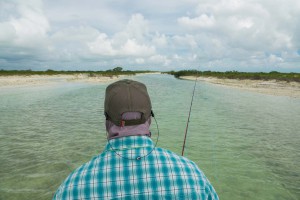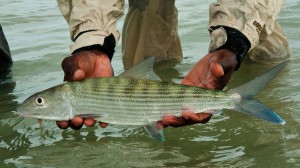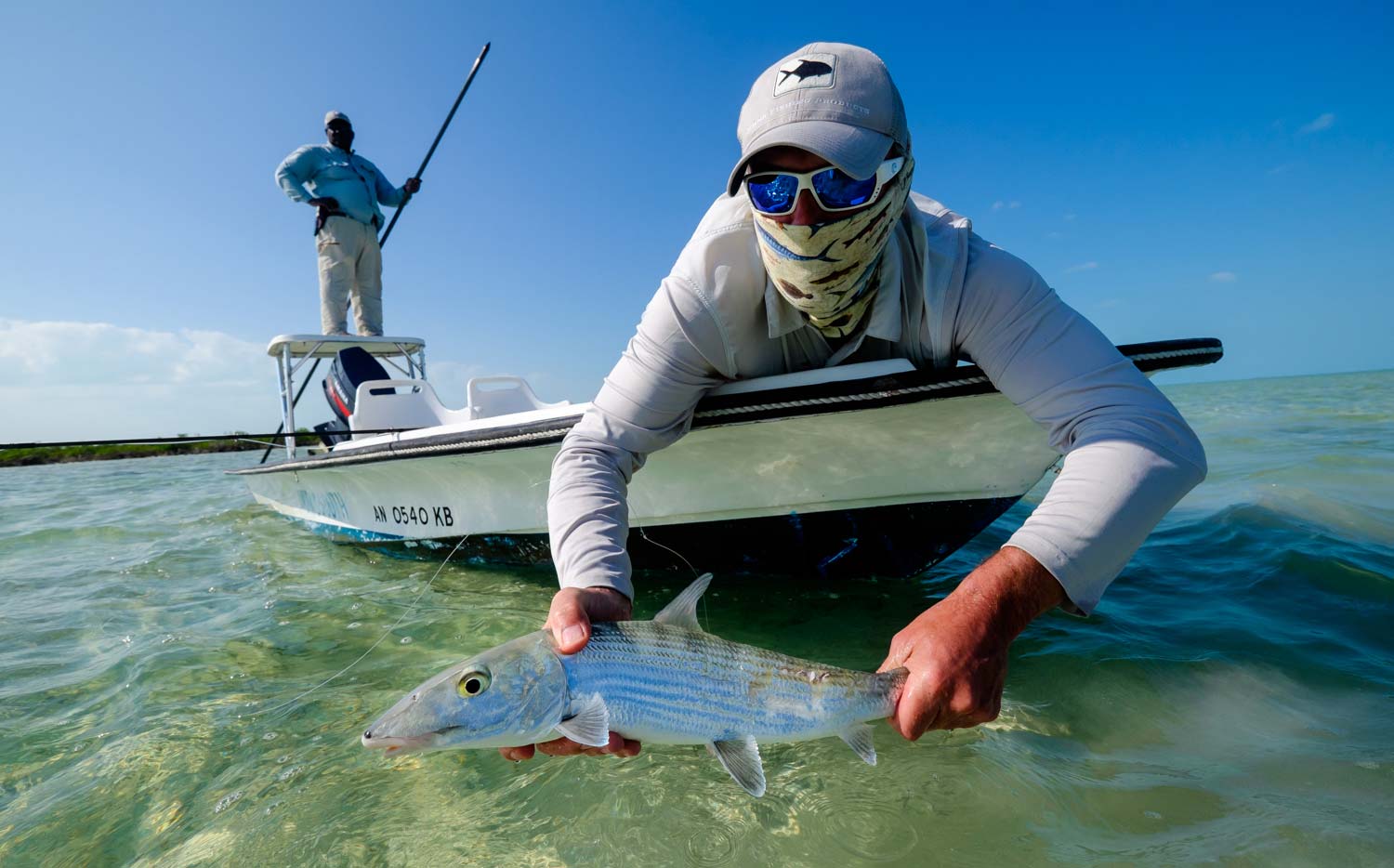By Jason Tucker
Trust your guide they say. Always trust your guide.
There is no more trustworthy bunch than the guides at Bair’s Lodge on Andros Island in the Bahamas. Why you wouldn’t trust them is beyond me. What is not to trust? In a real sense, in the South Andros backcountry, our lives will be in their hands- there is no freshwater, no cell phone signal, and I’ve taken to calling the miles of braided channels and flats with no distinguishing land features The Hall of Mirrors. If your guide cashes in his chips back here and peels off the poling platform, you are going to be royally screwed. If it weren’t for the sat phone in the emergency case, that is.
But it is one thing to carry your gear down to the skiff in the morning, shake your guide’s hand, look him in the eye and decide he’s trustworthy, and quite another to put that trust into practice on a flat with bonefish coming in hot. Perhaps we need to start our morning with those team-building trust drills that corporate consultants loved so much in the recent past. Put your fly rod down before you fall backward.
On one sunny Bahamas morning I found out what trusting your guide really means.
 Jack, a congenial gentleman from Connecticut, was catching fish and I was not. I believe he may have had three bonefish to the boat before I got my first. The difference? Jack never saw the fish he was hooking up on until he landed them. He just simply cast the direction and distance he was told when prompted by our guide. He trusted the guide and followed directions.
Jack, a congenial gentleman from Connecticut, was catching fish and I was not. I believe he may have had three bonefish to the boat before I got my first. The difference? Jack never saw the fish he was hooking up on until he landed them. He just simply cast the direction and distance he was told when prompted by our guide. He trusted the guide and followed directions.
I’m not used to working with a guide. I have always been a hard-boiled do-it-yourselfer. Until this trip my flats fishing had consisted of fishing for carp on the Great Lakes, not entirely dissimilar to this. Both involve spooky fish in shallow water in windy conditions. But I’ve always done it on my own and on foot.
What Jack was doing right, was casting and presenting the fly in the direction and distance the guide told him. I, still relying on my own senses, was pulling my casts and hesitating until I spotted the fish, but those extra seconds and moments were costing me. They were the difference between making a good presentation, or any presentation at all, and the fish spotting the boat. And you could see the difference as it unfolded- mid-cast as I searched the water to spot them, the posture and action of the fish would change, from relaxed to alert, and when my fly would land they would bolt. We didn’t have the luxury of relying on our own senses. We had to trust the guide.
Trust also means listening to your guide’s instructions once the cast is made.
Strip when he says strip; pause or wait when he says wait; set the hook when he says set. It’s too easy to be on auto pilot once the cast is made and strip the fly mechanically. You also tend to get tunnel vision, while the guide, not feeling the pressure, may have a better picture of what the fish is doing. Follow his directions, and when he says set, set!
 On day four we had the worst weather of the week. We started out with twenty mile an hour winds and thirty mile an hour gusts and rain that stung our faces as the skiff pounded across the waves. My boatmate was a gentleman named Mike, who insisted I fish first while he drank his coffee, then got on the bow and caught a tailing fish in short order. Then he sat back down and said “You’re up. I’m done.” So I got back on the bow and did my best to spot fish through the gray, foam-streaked surface of the water. At some point our guide called out “Fish. Three o’clock. Forty feet.” I somehow managed to make the cast, land it, and stick the fish, all without seeing it. It came off immediately, but I finally had the satisfaction of hooking up on a fish I never saw just by trusting the guide and making the cast.
On day four we had the worst weather of the week. We started out with twenty mile an hour winds and thirty mile an hour gusts and rain that stung our faces as the skiff pounded across the waves. My boatmate was a gentleman named Mike, who insisted I fish first while he drank his coffee, then got on the bow and caught a tailing fish in short order. Then he sat back down and said “You’re up. I’m done.” So I got back on the bow and did my best to spot fish through the gray, foam-streaked surface of the water. At some point our guide called out “Fish. Three o’clock. Forty feet.” I somehow managed to make the cast, land it, and stick the fish, all without seeing it. It came off immediately, but I finally had the satisfaction of hooking up on a fish I never saw just by trusting the guide and making the cast.
There is one more aspect to trust in a flats skiff which must be worked out ahead of time.
Make sure you and the guide are one the same page when it comes to the “clock”. Straight off the bow is always twelve o’clock. It doesn’t hurt to cast through the clock with your guide first thing in the morning to make sure you are in sync. I was under the impression that nine o’clock was to my 90 degrees left, and three o’clock was to my 90 degrees right. With a couple of my guides at least, their clock seemed to revolve around the center console and not the bow- three o’clock meant casting to my three-thirty, or even four. Having a firm understanding of what your guide means by three o’clock can save you a lot of grief and missed fish and is the very basis of trust when you are on the bow and the guide is calling out fish.
So on your first, or next, trip to the salt, prepare your mind to give up some control of your fishing and be ready to do what your guide says without relying on your own senses necessarily. If you’re used to fishing on your own this may take some practice. Flats fishing for bonefish is a team sport. There’s a balance to be struck, as you may spot the fish right away, or spot fish the guide hasn’t seen, but you also need to make those shots when the guide calls out a fish, and you see nothing. You will greatly increase your odds of hooking up.
Jason writes the fine blog Fontinalis Rising
Jason Tucker
Gink & Gasoline www.ginkandgasoline.com hookups@ginkandgasoline.com Sign Up For Our Weekly Newsletter!
Sign Up For Our Weekly Newsletter!


I found it best to sinc not only the clock, but distance as well. You need to be on the same page as your guide regarding distance! Fourty feet to one guide might be 50 feet from another guide and who knows what that distance is to you! Getting this sorted out first thing in the morning, especially if you are fishing with different guides, pays off in more fish hooked.
As another dedicated do-it-my-selfer…I’ve identified what it is and figured out how to suppress it, that hold me back from that last edge of “trust your guide”.
…I want to catch the fish myself…and there’s always that tiny nagging voice saying that if I do what the guide says, they really caught the fish…I just threw the cast…
But here’s the deal, for me: I never hire a guide to catch fish…I hire a guide to learn.
Sometimes it’s to learn how to catch fish…but just as often it’s to learn how to cast this way, or that way, or how to work my fly, or to learn what fly to to throw…and why…
…and to do any of that, I have to trust the guide, and listen, and watch, ask some questions…and listen some more…
Listening…really listening…is a lost art…
Yep, same same with a caddie in golf. Played a round with a caddie, a good caddie, as a guest at a private club recently. As a first-timer with a caddie of any kind, I simply did what he said. When he said “It’s uphill, add about 25% length and aim just to the right of this ballmark” I did just that. Clunk. Clunk. Clunk. Lowest number of putts in a round for me ever – by a lot! It was ridiculous. He told me that some people can’t/won’t resist adding their own “finesse” to what he tried to tell them to do, and they never fared nearly as well.